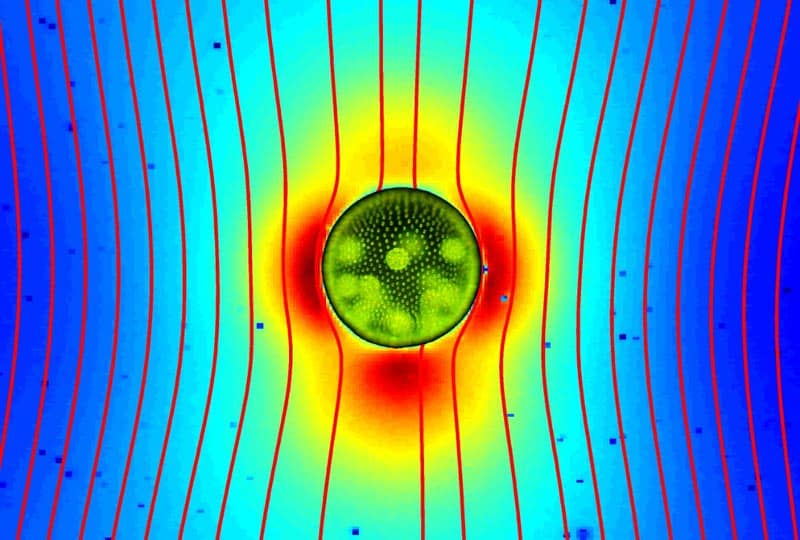These are 15 of our favourite images from 2010 presented in no particular order. Some are funny, some instructive and others are just plain beautiful. We hope you enjoy looking at them

No, that’s not a Frisbee balancing on a stalagmite – it’s an electron microscope image of the first all-optical transistor on a silicon chip. (Courtesy: EPFL.)
It could be a Hermes scarf, but it’s a photograph of topological defects created when a particle is placed in a liquid crystal. (Courtesy: Oleg Lavrentovich, Israel Lazo and Oleg Pishnyak.)
NASA’s Lunar Reconnaissance Orbiter (LRO) has been sweeping around the Moon for over a year and has delivered many spectacular pictures – including this one of the far side of the Moon. (Courtesy: NASA.)
This one made us laugh. On the left is an artist’s impression of a four-legged molecular motor, which walks much like a horse (right). (Courtesy: Ludwig Bartels.)
Why does Leonardo’s famous portrait of Mona Lisa have such natural grace? The answer could come from this X-ray fluorescence spectroscopy study at the Louvre. (Courtesy: Walter Philippe.)
This is our best view yet of “the face of God”, taken by ESA’s Planck space mission. What will this all-sky survey of the cosmic microwave background reveal about the origin of the universe? (Courtesy: ESA.)
Making a model of the Matterhorn just 25 nm tall must rank among the oddest of follies. But that’s just what Armin Knoll and colleagues at IBM in Switzerland and the US did using their new scanning probe lithography technique. (Courtesy: IBM Research, Zurich.)
Fantastic flares and eerie light from streams of electrons are just some of the stunning scenes of the Sun captured in high resolution by NASA’s Solar Dynamics Observatory (SDO), which was launched in February. (Courtesy: NASA.)
Magnetohydrodynamics may be a mouthful, but it does create stunning computer visualizations. These were made by Akira Kageyama and colleagues at the Earth Simulator supercomputer in Japan and show how molten iron could flow deep within our planet’s interior to generate the Earth’s magnetic field.
This scanning tunnelling microscope image is the first ever fractal pattern spotted in a quantum system. It was taken by Ali Yazdani and team at Princeton University in the US, who say that the fractal emerges when the doped gallium arsenide sample makes the transition from metal to insulator. (Courtesy: Yazdani Group, Princeton University.)
This year’s Nobel Prize for Physics went to Andre Geim (left) and Kostya Novoselov of the University of Manchester. We loved this serene shot of the two graphene gurus sitting outside on a lovely autumn day – the calm before the storm of fame struck. (Courtesy: University of Manchester.)
Oops! There goes the neighbourhood. This amazing 60 m “sinkhole” suddenly appeared this year in Guatemala City. Geophysicists say that such collapses can occur when liquids flow into an underground cavity causing it to corrode into a network of chambers that can no longer support the overlying rock and soil. (Courtesy: Guatemalan Government.)
Do these concentric circles offer a glimpse of before the Big Bang? Roger Penrose and Vahe Gurzadyn came to this conclusion after studying images of the cosmic microwave background radiation. However, other physicists are not convinced. (Courtesy: Penrose and Gurzadyn.)
The oceans are full of tiny organisms like this alga. Their constant swimming plays an important, yet poorly understood, role in the transport of heat and nutrients. The colours and contours show how water flows past the moving alga. (Courtesy: K Drescher and colleagues, University of Cambridge.)
Remember that scene in Star Wars when a hologram of Princess Leia pops out of R2D2? Now, Nasser Peyghambarian and colleagues at the University of Arizona and Nitto Denko Technical Corporation have taken an important step towards creating such an animation. This is their version of an F-4 Phantom Jet. (Courtesy: gargaszphotos.com/University of Arizona.)

















